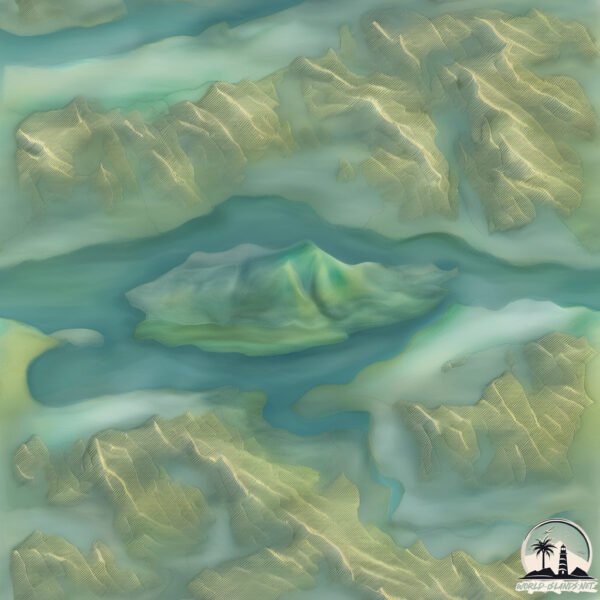Cooper

Welcome to Cooper, a Temperate island in the Tasman Sea, part of the majestic Pacific Ocean. This guide offers a comprehensive overview of what makes Cooper unique – from its geography and climate to its population, infrastructure, and beyond. Dive into the details:
- Geography and Size: Explore the island’s size and location.
- Climate and Weather: Weather patterns and temperature.
- Topography and Nature: Uncover the natural wonders of the island.
- Infrastructure and Travelling: Insights on reaching, staying, and making the most of your visit.
- News and Headlines: Latest News.
Geography and size of Cooper
Size: 18.3 km²
Coastline: 26.7 km
Ocean: Pacific Ocean
Sea: Tasman Sea
Continent: Oceania
Cooper is a Medium Island spanning 18 km² with a coastline of 27 km.
Archipel: Polynesia – A region of more than 1,000 islands in the central and southern Pacific Ocean, known for their diverse Polynesian cultures, stunning landscapes, and marine biodiversity.
Tectonic Plate: Pacific – The world’s largest tectonic plate, covering much of the Pacific Ocean, known for the Pacific Ring of Fire with extensive seismic and volcanic activity.
The geographic heart of the island is pinpointed at these coordinates:
Latitude: -45.73470954 / Longitude: 166.83137962
Climate and weather of Cooper
Climate Zone: Temperate
Climate Details: Temperate Oceanic Climate
Temperature: Warm Summer
Climate Characteristics: Known for its moderate year-round temperatures with ample rainfall and no dry season. Warm summers are characteristic.
Topography and nature of Cooper
Timezone: UTC+12:00
Timezone places: Pacific/Auckland
Max. Elevation: 399 m
Mean Elevation: 182 m
Vegetation: Evergreen Broadleaf Forest
Tree Coverage: 96%
The mean elevation is 182 m. The highest elevation on the island reaches approximately 399 meters above sea level. The island is characterized by Hills: Gently sloping landforms with rounded tops, having a maximum elevation between 200 and 500 meters. Hills contribute to a varied landscape on islands.
Dominating Vegetation: Evergreen Broadleaf Forest
Characterized by dense, lush canopies of broadleaf trees that retain their leaves year-round. These forests are typically found in tropical and subtropical regions and are known for their high biodiversity. Cooper has a tree cover of 96 %.
Vegetation: 3 vegetation zones – Moderately Diverse Island
These islands start to show a broader range of ecological niches. With three vegetation zones, they may offer a mix of ecosystems like coastal areas, inland woods, and perhaps a distinct wetland or dry area. This diversity supports a wider range of flora and fauna, making these islands more ecologically complex than those with minimal diversity.
Infrastructure and Travelling to Cooper
Does the island have a public airport? no.
There is no public and scheduled airport on Cooper. The nearest airport is Invercargill Airport, located 175 km away.
Does the island have a major port? no.
There are no major ports on Cooper. The closest major port is BLUFF HARBOR, approximately 187 km away.
The mean population of Cooper is 0 per km². Cooper is Uninhabited. The island belongs to New Zealand.
Continuing your journey, Long is the next notable island, situated merely km away.
Cooper Island Resort - Official Brand Video | British Virgin Islands



New Zealand is classified as Developed region: G7: Group of Seven – Major advanced economies, including Canada, France, Germany, Italy, Japan, the United Kingdom, and the United States. The level of income is High income: OECD.
News – Latest Updates and Headlines from Cooper
Stay informed with the most recent news and important headlines from Cooper. Here’s a roundup of the latest developments.
- Coopers Island Road proposal dominates council's public access meeting - About Regionalon 10 December 2025
Coopers Island Road proposal dominates council's public access meeting About Regional
- UPDATED: Eurobodalla Shire Council proposal to close Coopers Island Road raises concerns - About Regionalon 28 November 2025
UPDATED: Eurobodalla Shire Council proposal to close Coopers Island Road raises concerns About Regional
- Council proposing Coopers Island Road closure - Eurobodalla Councilon 10 November 2025
Council proposing Coopers Island Road closure Eurobodalla Council
- HSBC staff roll up their sleeves for clean-up effort - Royal Gazette | Bermudaon 6 November 2025
HSBC staff roll up their sleeves for clean-up effort Royal Gazette | Bermuda
- Photos: HSBC Help Clean Up Cooper’s Island - Bernewson 6 November 2025
Photos: HSBC Help Clean Up Cooper’s Island Bernews
- Love Island Australia star Cooper Benson sentenced after violent karaoke bar fight - The Tabon 28 October 2025
Love Island Australia star Cooper Benson sentenced after violent karaoke bar fight The Tab
- Sentenced Love Island star failed to reveal brawl to show producers - Daily Mailon 21 October 2025
Sentenced Love Island star failed to reveal brawl to show producers Daily Mail
- Upcoming Love Island star sentenced after violent karaoke bar brawl on the Gold Coast ahead of new series - Daily Mailon 14 October 2025
Upcoming Love Island star sentenced after violent karaoke bar brawl on the Gold Coast ahead of new series Daily Mail
- I Took a Moorings Yacht Charter in the British Virgin Islands — And It Was the Ultimate Caribbean Adventure - Caribbean Journalon 5 September 2025
I Took a Moorings Yacht Charter in the British Virgin Islands — And It Was the Ultimate Caribbean Adventure Caribbean Journal
- These Are the Hidden Gems of the British Virgin Islands, From Norman Island to Prickly Pear - Caribbean Journalon 3 August 2025
These Are the Hidden Gems of the British Virgin Islands, From Norman Island to Prickly Pear Caribbean Journal
Please note: The data used here has been primarily extracted from satellite readings. Deviations from exact values may occur, particularly regarding the height of elevations and population density. Land area and coastline measurements refer to average values at mean high tide.
